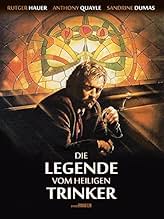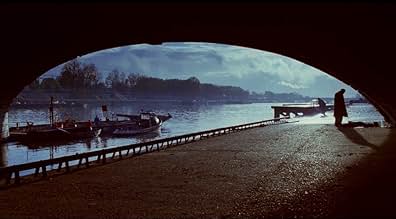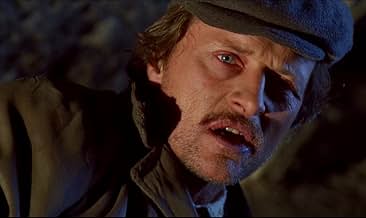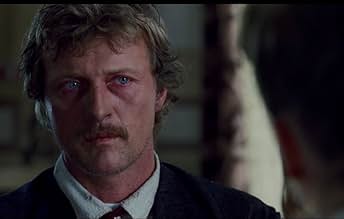NOTE IMDb
7,1/10
2,4 k
MA NOTE
Un sans-abri alcoolique se voit remettre deux cents francs par un étranger, qui lui demande de rendre l'argent à Sainte Thérèse dans la cathédrale lorsqu'il le pourra.Un sans-abri alcoolique se voit remettre deux cents francs par un étranger, qui lui demande de rendre l'argent à Sainte Thérèse dans la cathédrale lorsqu'il le pourra.Un sans-abri alcoolique se voit remettre deux cents francs par un étranger, qui lui demande de rendre l'argent à Sainte Thérèse dans la cathédrale lorsqu'il le pourra.
- Réalisation
- Scénario
- Casting principal
- Récompenses
- 12 victoires et 3 nominations au total
Francesco Aldighieri
- Policeman
- (as Franco Aldighieri)
Avis à la une
A drunken homeless man (Rutger Hauer) in Paris is lent 200 francs by a stranger (Anthony Quayle) as long as he promises to repay it to a local church when he can afford to; the film depicts the man's constant frustrations as he attempts to do so.
This project started when producer Roberto Cicutto (Hotel Rwanda) bought the rights to Roth's book of the same name. A few directors were approached and turned the film down because the plot was too "thin" and "vague". Finally, Ermanno Olmi (Tree of Wooden Clogs) was suggested by Tullio Kezich's wife, and he accepted. Perhaps because of modesty, Kezich suggests that Olmi wrote the bulk of the script, with Kezich merely "watching him work". Kezich is best known as the film critic for Corriere della Sera and for his award-winning biography of director Federico Fellini.
According to Kezich, Robert DeNiro wanted the lead role, and Cicutto flew him to Europe to meet with Olmi. DeNiro was in awe of Olmi, but apparently the feeling was not mutual. Oddly, Rutger Hauer was wanted by Olmi because of his role in "The Hitcher" (1986), which makes little sense. Hauer himself concedes that he was more comfortable with action, and less comfortable with nuance.
In fact, Hauer was probably a better choice than DeNiro, despite the latter's bigger star power. Hauer is quite effective as the alcoholic, not overdoing it. The way he is dressed and presents himself makes the "holy drinker" an interesting character because on the surface he appears quite well-to-do when, in fact, he sleeps under a bridge.
Worth noting is Anthony Quayle, who has a small but important part, as he really commands attention from the audience just with his presence. Unlike Hauer, Quayle was primarily a stage actor, steeped in Broadway and Shakespeare. This may be why he so naturally comes off as "distinguished" because he certainly was.
The film won the Golden Lion at the 45th edition of the Venice Film Festival. It also won four David di Donatello Awards (for best film, best director, Best cinematography and best editing) and two Silver Ribbons (for best director and best screenplay). The film was selected as the Italian entry for the Best Foreign Language Film at the 61st Academy Awards, though it was not accepted as a nominee.
This mysterious tale -- almost a dark, dry comedy -- really comes to life on the Arrow Blu-ray. The special features are fairly slim, though the 25-minute interview with Kezich is enlightening and the 10-minute interview with Hauer is a joy. The best thing about this film is that it is now going to be available to a new audience. Though not well-known, it ought to be. In this reviewer's humble opinion, "Holy Drinker" is superior to "Tree of Wooden Clogs", and may be Hauer's finest role.
This project started when producer Roberto Cicutto (Hotel Rwanda) bought the rights to Roth's book of the same name. A few directors were approached and turned the film down because the plot was too "thin" and "vague". Finally, Ermanno Olmi (Tree of Wooden Clogs) was suggested by Tullio Kezich's wife, and he accepted. Perhaps because of modesty, Kezich suggests that Olmi wrote the bulk of the script, with Kezich merely "watching him work". Kezich is best known as the film critic for Corriere della Sera and for his award-winning biography of director Federico Fellini.
According to Kezich, Robert DeNiro wanted the lead role, and Cicutto flew him to Europe to meet with Olmi. DeNiro was in awe of Olmi, but apparently the feeling was not mutual. Oddly, Rutger Hauer was wanted by Olmi because of his role in "The Hitcher" (1986), which makes little sense. Hauer himself concedes that he was more comfortable with action, and less comfortable with nuance.
In fact, Hauer was probably a better choice than DeNiro, despite the latter's bigger star power. Hauer is quite effective as the alcoholic, not overdoing it. The way he is dressed and presents himself makes the "holy drinker" an interesting character because on the surface he appears quite well-to-do when, in fact, he sleeps under a bridge.
Worth noting is Anthony Quayle, who has a small but important part, as he really commands attention from the audience just with his presence. Unlike Hauer, Quayle was primarily a stage actor, steeped in Broadway and Shakespeare. This may be why he so naturally comes off as "distinguished" because he certainly was.
The film won the Golden Lion at the 45th edition of the Venice Film Festival. It also won four David di Donatello Awards (for best film, best director, Best cinematography and best editing) and two Silver Ribbons (for best director and best screenplay). The film was selected as the Italian entry for the Best Foreign Language Film at the 61st Academy Awards, though it was not accepted as a nominee.
This mysterious tale -- almost a dark, dry comedy -- really comes to life on the Arrow Blu-ray. The special features are fairly slim, though the 25-minute interview with Kezich is enlightening and the 10-minute interview with Hauer is a joy. The best thing about this film is that it is now going to be available to a new audience. Though not well-known, it ought to be. In this reviewer's humble opinion, "Holy Drinker" is superior to "Tree of Wooden Clogs", and may be Hauer's finest role.
This tale of a tramp who is the recipient of the milk of human kindness but who finds it difficult to repay the goodness shown to him is typical of its director, Ermanno Olmi, but whereas other Olmi films deal with the common-place with an uncommon beauty this tale of the mystical is overtly simplistic. "The Legend of the Holy Drinker" is visually superb and we should expect nothing less from an Olmi picture but it is also very dry, very dull and very unevenly acted, (the partial dubbing of its international cast certainly doesn't help).
As the tramp Rutger Hauer staggers around looking a little too bewildered at what's happening to him and the supporting cast are fundamentally just bit players in his far from interesting story. The Stravinsky score also sits somewhat uneasily on proceedings. Some people think this is a masterpiece while others have simply dismissed it. Personally I found it a crashing bore.
As the tramp Rutger Hauer staggers around looking a little too bewildered at what's happening to him and the supporting cast are fundamentally just bit players in his far from interesting story. The Stravinsky score also sits somewhat uneasily on proceedings. Some people think this is a masterpiece while others have simply dismissed it. Personally I found it a crashing bore.
Takeaway Scene
Rutger Hauer's biggest, joyful smile is for a bathtub.
The Good This is one of very few successful screen transpositions of an introspective literary work. The dialogue is sparse and in two languages but the film while making small adjustments here and there conveys all the internal monologue of Joseph roth's novella. Hauer. Probably his best performance (although I also like his understated character in lady Hawke). He is the icon of a getleman drunk. The photography. natural, unobtrusive, realistic. The cast: A very heterogeneous looking cast that manages to fit in well and act natural in their respective roles. The women: For a very Catholic director, Olmi is very kind to almost the women in the movie, including extras, and they look attractive without losing their real, unpolished authenticit
The Not So Good The film is almost real time,with long contemplative moments, to the point that sometimes the flashbacks have more action that the main scene. For all its photographical and acting beauty, the going can be slow, and watching Hauer drinking one longs to join in. I haven't counted them, but I suspect that matching the movie glass for glass would be lethal (especially the Cafe'-Calva followed by an Absinthe in the morning)
The Strange Hauer is a character living and dressing in the 1930s filmed in 1980s Paris. And it fits seamlessly, the same way that the real, surviving old bistrots and locations fit in their modern surroundings. Olmi has taken advantage of a phenomenon familiar to us all walking in cities and performed a sleight of hand trick, aided by the costume design of Ms. Marchand that emphasizes the continuity between periods to blend characters in.
The Good This is one of very few successful screen transpositions of an introspective literary work. The dialogue is sparse and in two languages but the film while making small adjustments here and there conveys all the internal monologue of Joseph roth's novella. Hauer. Probably his best performance (although I also like his understated character in lady Hawke). He is the icon of a getleman drunk. The photography. natural, unobtrusive, realistic. The cast: A very heterogeneous looking cast that manages to fit in well and act natural in their respective roles. The women: For a very Catholic director, Olmi is very kind to almost the women in the movie, including extras, and they look attractive without losing their real, unpolished authenticit
The Not So Good The film is almost real time,with long contemplative moments, to the point that sometimes the flashbacks have more action that the main scene. For all its photographical and acting beauty, the going can be slow, and watching Hauer drinking one longs to join in. I haven't counted them, but I suspect that matching the movie glass for glass would be lethal (especially the Cafe'-Calva followed by an Absinthe in the morning)
The Strange Hauer is a character living and dressing in the 1930s filmed in 1980s Paris. And it fits seamlessly, the same way that the real, surviving old bistrots and locations fit in their modern surroundings. Olmi has taken advantage of a phenomenon familiar to us all walking in cities and performed a sleight of hand trick, aided by the costume design of Ms. Marchand that emphasizes the continuity between periods to blend characters in.
Olmi is one of Europe's last Old Masters in the art of film making. He is usually regarded as a belated neo-realist, but after you've seen "The Legend of the Holy Drinker", you will realize the label simply does not stick. This is a film about spirituality, about communion, one of the most deeply religious movies ever, whose only rivals might be Dreyer's "Ordet" or Bergman's rather pretentious "faith trilogy" ("Through a Glass Darkly", "Winter Light" and "The Silence"). However, you will not find Scandinavian mists or angst in Catholic Olmi's adaptation of the beautiful novella written, oddly enough, by a great Jewish novelist, Joseph Roth. Wine is a metaphor for life, and Paris is a metaphor for our urban world. In this symbolic universe, it takes a great actor to give flesh and blood to the character of Andreas, the holy drinker, a beggar endowed with an amazing sense of dignity. Rutger Hauer was the man for the job: this was his best performance: he was never better, and, to judge from the course his career has taken, I fear he will never be better than in this film. It is not a thriller, but it is thrilling. It takes its own leisurely pace, but goes very far, very deep indeed into the human soul. After so many insipid or unpalatable cinematic concoctions, treat yourself to this film: it truly is vintage stuff.
10duinnuk2
This simple tale is told at a pace which allows the audience time to reflect within the context of the moral challenges it presents. The result is a level of engagement far superior to the gamut of empty sophistication in the movie world. One is able to explore the implications of the actions and decisions of Hauer's character without leaving the narrative - there is no pressure for post viewing reflection when the spell of the film is broken and thought is coloured by a context inappropriate to the narrative. Here is a complete experience - moving, profound and visually beautiful - if only Hollywood could produce cinema of this standard.
Le saviez-vous
- AnecdotesRobert De Niro was approached for the role of Andreas Kartak, but he turned down the offer because he was not convinced about the project.
- ConnexionsFeatured in Het uur van de wolf: Rutger Hauer: Blond, blue eyes (2006)
Meilleurs choix
Connectez-vous pour évaluer et suivre la liste de favoris afin de recevoir des recommandations personnalisées
- How long is The Legend of the Holy Drinker?Alimenté par Alexa
Détails
- Date de sortie
- Pays d’origine
- Langues
- Aussi connu sous le nom de
- The Legend of the Holy Drinker
- Lieux de tournage
- Sociétés de production
- Voir plus de crédits d'entreprise sur IMDbPro
Box-office
- Montant brut mondial
- 6 384 $US
- Durée2 heures 8 minutes
- Couleur
- Mixage
- Rapport de forme
- 1.85 : 1
Contribuer à cette page
Suggérer une modification ou ajouter du contenu manquant

Lacune principale
What is the German language plot outline for La légende du saint buveur (1988)?
Répondre






















